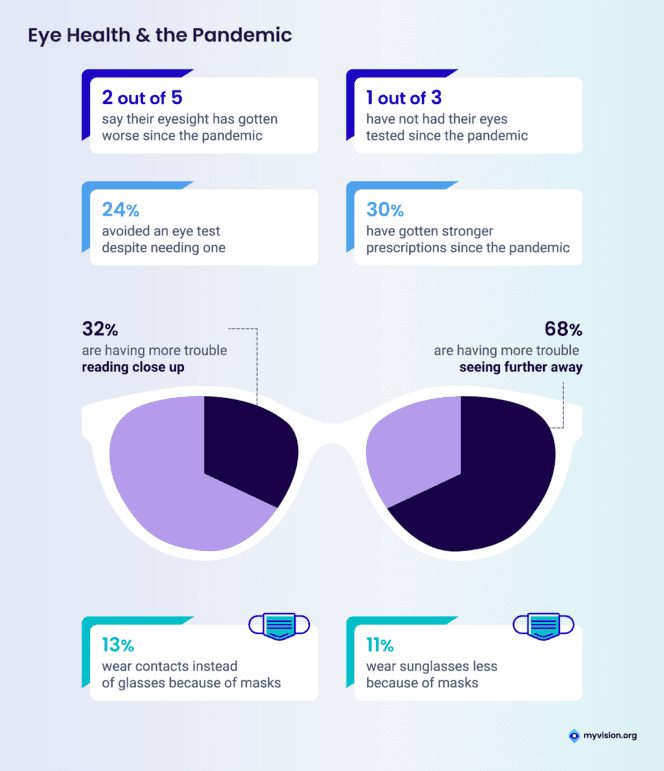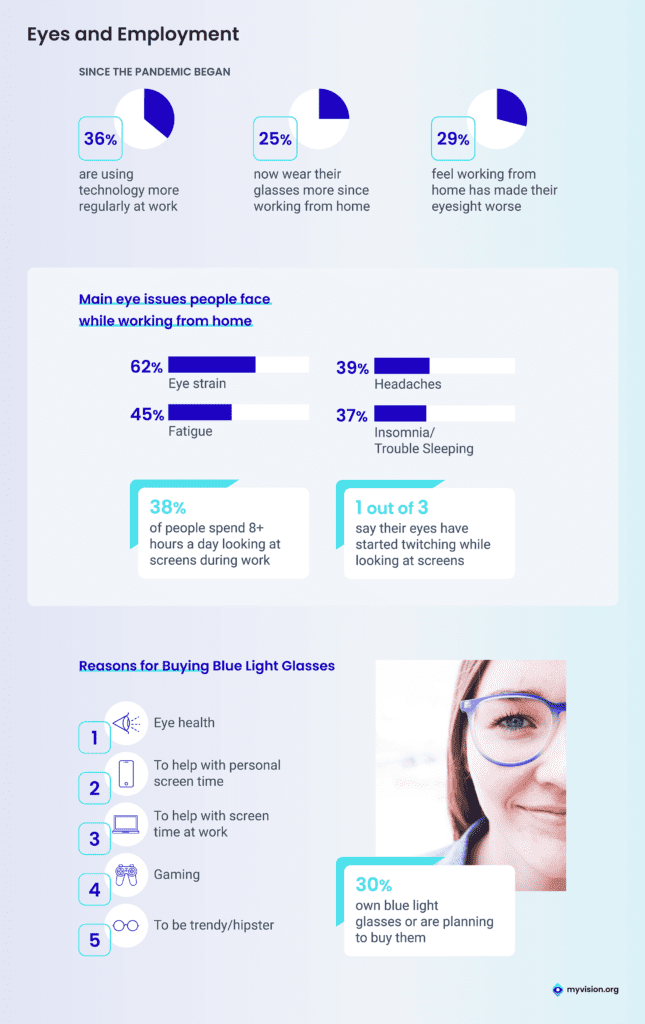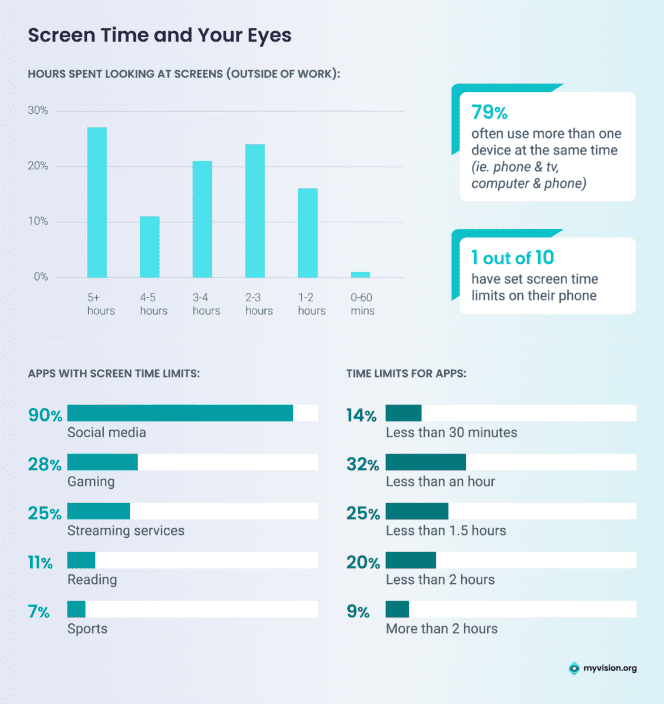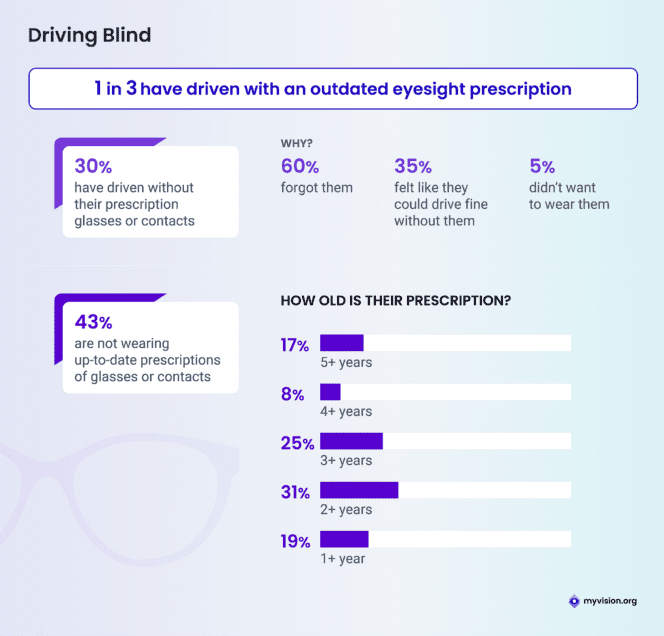Technology has become more of a necessity than a luxury, especially since the COVID-19 pandemic began. While technology does help connect us, excessive screen time can also lead to problems like eye strain. Because of this, we were curious to see if the pandemic has led to more eye issues in the last two years.
We surveyed more than 1,000 people who wear glasses and/or contacts to get feedback on their eye health and eye habits throughout the past few years. Turns out that many people are having vision problems…but are putting off going to the doctor.

Two out of five people admit their eyesight has gotten worse since the onset of the pandemic. Nearly 70% report having more trouble seeing further away, and almost one-third are dealing with issues reading up close. Since March 2020, three out of 10 people have gotten stronger prescriptions for their glasses or contacts.
But of those struggling to see, many are not ready to seek help. One out of three admits to not getting their eyes checked over the last two years. In fact, 25% say they’ve actually avoided getting an eye test, even though they know they need one!
Masks have also impacted how people wear glasses. More than one in 10 (13%) say they wear contacts now instead of glasses, purely because of masks. Meanwhile, 25% of respondents say they wear their glasses more because of remote work.

Technology has taken over workplaces in America. Almost one in four (38%) say they spend more than eight hours a day looking at screens for their jobs. That comes with a cost. 29% say they feel that working from home has made their eyesight worse.
The top issues facing people who work remotely include eye strain, fatigue, headaches, and trouble sleeping. One out of every three surveyed adds that their eyes have started twitching while looking at screens.
Some people are trying to combat those issues. 30% said they either own blue light glasses or are planning to buy some soon. Others say they wear blue light glasses specifically to help with personal or work screen time. A small group of respondents wants the glasses just to be “trendy.”

In addition to long screen use at work, people are adding to that strain by also looking at screens in their free time. The majority of people (27%) estimate they spend an additional five or more hours each day looking at screens for personal use. 79% admit to juggling multiple screens at once; meaning they’re watching TV and looking at their phone at the same time.
Some respondents are trying their best to cut back on screen time. One out of 10 has set limits for screen use on their phones. Overwhelmingly, 90% of people are setting limits on social media apps. One out of four people is cutting back on binge-watching and limiting their use of streaming services.
Almost half of the people (46%) set their limit to be less than an hour, however, others are allowing themselves more time on these apps. Nearly one out of 10 (9%) say their time limit is more than two hours.

Driving, in general, is already dangerous, but what we found about drivers with poor eyesight is especially concerning. One out of three drivers say they’ve driven with an outdated eyesight prescription.
Even more surprising, three out of 10 admit to driving without their prescription glasses or contacts altogether! Why would someone take that risk? The majority (60%) report just forgetting their contacts or glasses. However, two out of five either felt like they could drive fine without that vision help, or they just did not want to wear them.
A lot of people wear old glasses or contacts every day. 43% say they are not wearing up-to-date prescriptions. More than 8 out of 10 people are wearing prescriptions that are two years or older. Of those, 17% told us their glasses or contact prescriptions are more than five years old.

Glasses and contacts are expensive, and when something breaks, many aren’t willing to pay to have it fixed. Nearly one-third of people say they’ve worn cracked or broken glasses.
Contact wearers also admit to not replacing their contacts, or even taking them out at the end of the day. 24% admitted to wearing two-week contact lenses for longer than two weeks, and 1 in 4 have slept with their contacts in.
Since the pandemic began, 13% of people say they’ve spent more than $500 on their eye health. Two-thirds of people have spent about $500 or less. Main purchases include prescription glasses, contact lenses, and blue light glasses. With summer approaching, 24% are planning on buying prescription sunglasses.
Others are considering a more permanent solution. Nearly one-third (32%) of people have gotten Lasik surgery, or are planning to get it. The main reason is to fix their eye problems altogether and its convenience. Nearly half (44%) say they consider Lasik an investment, so they no longer have to keep paying for glasses or contacts. But 36% admit to just getting tired of waiting up blind every morning.
The pandemic has pushed the world into a place where technology is an essential part of everyday life. That means screen time issues are not going away anytime soon. If you use technology daily, follow the 20-20-20 rule. Every 20 minutes, look away from your screen and focus on something that is 20 feet away. Do it for at least 20 seconds to give your eyes a break. We also encourage you to always get your eyes checked regularly, and go to a doctor if you are having trouble seeing.
Methodology
In April 2022, we surveyed 1,121 people who wear contacts and/or glasses to get their feedback about eye habits and the pandemic. Survey respondents ranged in age from 18 to 80 with an average age of 40. Of the respondents, 49% were male and 49% female.
For media inquiries, please contact media@digitalthirdcoast.net.
Fair Use
When using this data and research, please attribute by linking to this study and citing https://myvision.org/guides/pandemic-eyewear-habits.
Last Updated April 19, 2022
Note: This page should not serve as a substitute for professional medical advice from a doctor or specialist. Please review our about page for more information.